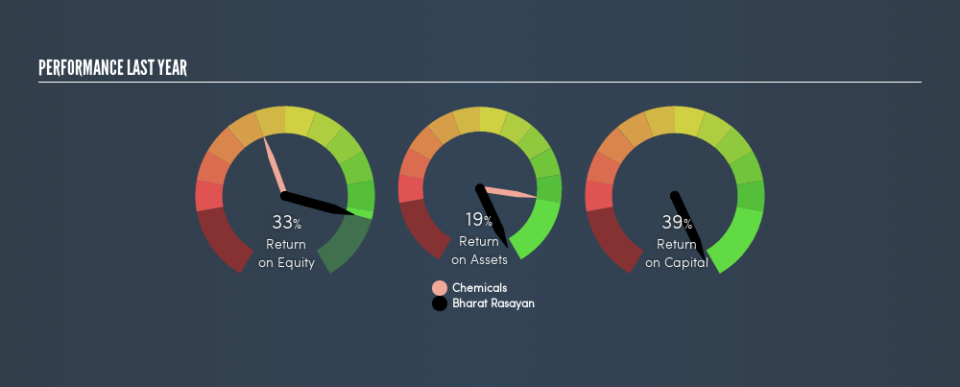Why Bharat Rasayan Limited’s (NSE:BHARATRAS) Return On Capital Employed Is Impressive

Today we'll look at Bharat Rasayan Limited (NSE:BHARATRAS) and reflect on its potential as an investment. In particular, we'll consider its Return On Capital Employed (ROCE), as that can give us insight into how profitably the company is able to employ capital in its business.
First up, we'll look at what ROCE is and how we calculate it. Next, we'll compare it to others in its industry. Finally, we'll look at how its current liabilities affect its ROCE.
Return On Capital Employed (ROCE): What is it?
ROCE measures the amount of pre-tax profits a company can generate from the capital employed in its business. Generally speaking a higher ROCE is better. In brief, it is a useful tool, but it is not without drawbacks. Renowned investment researcher Michael Mauboussin has suggested that a high ROCE can indicate that 'one dollar invested in the company generates value of more than one dollar'.
So, How Do We Calculate ROCE?
The formula for calculating the return on capital employed is:
Return on Capital Employed = Earnings Before Interest and Tax (EBIT) ÷ (Total Assets - Current Liabilities)
Or for Bharat Rasayan:
0.39 = ₹1.6b ÷ (₹6.9b - ₹2.8b) (Based on the trailing twelve months to December 2018.)
So, Bharat Rasayan has an ROCE of 39%.
View our latest analysis for Bharat Rasayan
Is Bharat Rasayan's ROCE Good?
One way to assess ROCE is to compare similar companies. Using our data, we find that Bharat Rasayan's ROCE is meaningfully better than the 16% average in the Chemicals industry. I think that's good to see, since it implies the company is better than other companies at making the most of its capital. Setting aside the comparison to its industry for a moment, Bharat Rasayan's ROCE in absolute terms currently looks quite high.
It is important to remember that ROCE shows past performance, and is not necessarily predictive. ROCE can be deceptive for cyclical businesses, as returns can look incredible in boom times, and terribly low in downturns. This is because ROCE only looks at one year, instead of considering returns across a whole cycle. Since the future is so important for investors, you should check out our free report on analyst forecasts for Bharat Rasayan.
Bharat Rasayan's Current Liabilities And Their Impact On Its ROCE
Current liabilities include invoices, such as supplier payments, short-term debt, or a tax bill, that need to be paid within 12 months. The ROCE equation subtracts current liabilities from capital employed, so a company with a lot of current liabilities appears to have less capital employed, and a higher ROCE than otherwise. To counter this, investors can check if a company has high current liabilities relative to total assets.
Bharat Rasayan has total assets of ₹6.9b and current liabilities of ₹2.8b. As a result, its current liabilities are equal to approximately 41% of its total assets. Bharat Rasayan has a medium level of current liabilities, boosting its ROCE somewhat.
What We Can Learn From Bharat Rasayan's ROCE
Still, it has a high ROCE, and may be an interesting prospect for further research. Bharat Rasayan shapes up well under this analysis, but it is far from the only business delivering excellent numbers . You might also want to check this free collection of companies delivering excellent earnings growth.
For those who like to find winning investments this free list of growing companies with recent insider purchasing, could be just the ticket.
We aim to bring you long-term focused research analysis driven by fundamental data. Note that our analysis may not factor in the latest price-sensitive company announcements or qualitative material.
If you spot an error that warrants correction, please contact the editor at editorial-team@simplywallst.com. This article by Simply Wall St is general in nature. It does not constitute a recommendation to buy or sell any stock, and does not take account of your objectives, or your financial situation. Simply Wall St has no position in the stocks mentioned. Thank you for reading.


